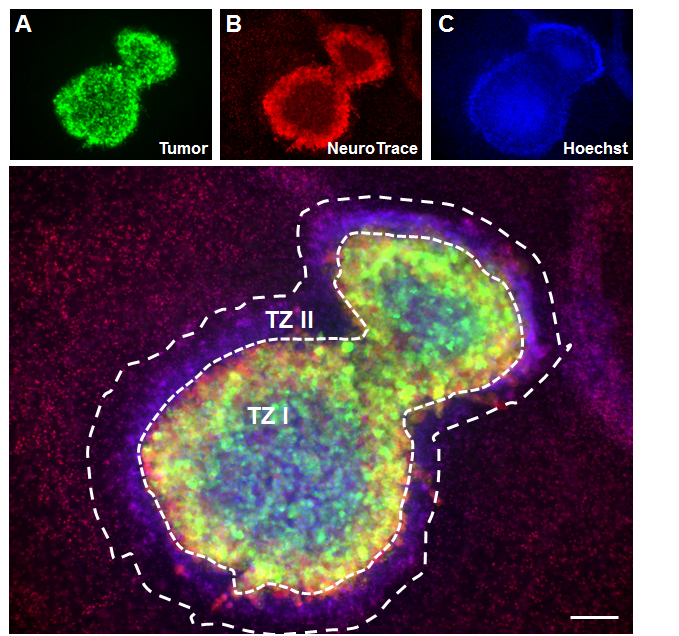New model for vascular and tumour research

Tumour-induced cell death and tumour zones I and II. The tumour is shown in green, damaged neurons are shown in red and cell nuclei are shown in blue.
Two characteristic features of malignant tumours are that they form massive blood vessels and bypass the immune system. A new cell culture technique allows the processes of tumour growth to be studied directly and in real time, without the need for complex experiments using live animals.
The researchers at Friedrich-Alexander-Universität Erlangen-Nürnberg (FAU) who developed the technique looked specifically at brain tumours. The team led by neuroscientist PD Dr. Nicolai Savaskan developed a 3D cell culture technique called the Vascular Organotypic Glioma Impact Model (VOGIM) which allows the formation of tumour blood vessels and their interaction with immune cells to be observed over a period of several days in an organotypic context.
This new method will allow new medications and therapies to be analysed directly, and enable side effects to be identified more quickly and efficiently than when using conventional cell culture techniques. VOGIM also allows the amount of animal testing required in vascular studies to be reduced. The results of the study by researchers at the Department of Neurosurgery at Universitätsklinikum Erlangen have now been published in the journal ONCOTARGET.
'VOGIM is a complex technique that allows tumours to be studied in real time and under clinically realistic conditions – without the need for live animal testing,' says Dr. Nicolai Savaskan, who led the study. In the technique tissue samples from rodent brains are infected with tumour cells expressing fluorescent reporter genes.
The growth of tumour cells and blood vessels, cell death, and the influence of medications on these developments are observed in the experiment. 'Even though VOGIM still requires some animal testing, it is a great technique. It can be used to test the effectiveness of new medications and molecules against gliomas – tumours of the central nervous system – relatively quickly and in a way that is reproducible,' Dr. Savaskan explains.
'We can also use it to study the side effects of almost any medication.' The next goal of the Erlangen-based researchers is to test new hybrid molecules from the plant and animal kingdom in this system in order to quickly develop new treatment strategies.
Brain tumours have destructive effects on the surrounding cells and blood vessels. Accumulations of serum around the tumour are a common symptom. These cause swelling in the brain and increase pressure inside the skull to dangerous levels.
In the worst case, the swelling can cause pressure on the respiratory centre above the cervical spine, quickly leading to suffocation. The cause of this swelling in the brain are pathological changes to the tumour blood vessels and disruption of the immune response to the brain tumour.
The accumulations of serum are caused by the tumour cells which damage surrounding tissue and cells, making them more permeable. The new VOGIM technique allows the tumour blood vessels and the immune system of the brain to be observed closely and the influence of new therapeutics to be studied in this context.
Original publication: Ali Ghoochani, Eduard Yakubov, Tina Sehm, Zheng Fan, Stefan Hock, Michael Buchfelder, Ilker Y. Eyüpoglu, Nicolai E. Savaskan: A versatile ex vivo technique for assaying tumor angiogenesis and microglia in the brain. ONCOTARGET 2015.
DOI: 10.18632/oncotarget.6550
Full text: http://www.impactjournals.com/oncotarget/index.php?journal=oncotarget&page=a…
Further information:
PD Dr. Nicolai Savaskan
Phone: +49 9131 8544748
nicolai.savaskan@uk-erlangen.de
Patient information:
Phone: +49 9131 8549000
krebsinformation@uk-erlangen.de
Media Contact
More Information:
http://www.fau.de/All latest news from the category: Health and Medicine
This subject area encompasses research and studies in the field of human medicine.
Among the wide-ranging list of topics covered here are anesthesiology, anatomy, surgery, human genetics, hygiene and environmental medicine, internal medicine, neurology, pharmacology, physiology, urology and dental medicine.
Newest articles

A universal framework for spatial biology
SpatialData is a freely accessible tool to unify and integrate data from different omics technologies accounting for spatial information, which can provide holistic insights into health and disease. Biological processes…

How complex biological processes arise
A $20 million grant from the U.S. National Science Foundation (NSF) will support the establishment and operation of the National Synthesis Center for Emergence in the Molecular and Cellular Sciences (NCEMS) at…

Airborne single-photon lidar system achieves high-resolution 3D imaging
Compact, low-power system opens doors for photon-efficient drone and satellite-based environmental monitoring and mapping. Researchers have developed a compact and lightweight single-photon airborne lidar system that can acquire high-resolution 3D…





















